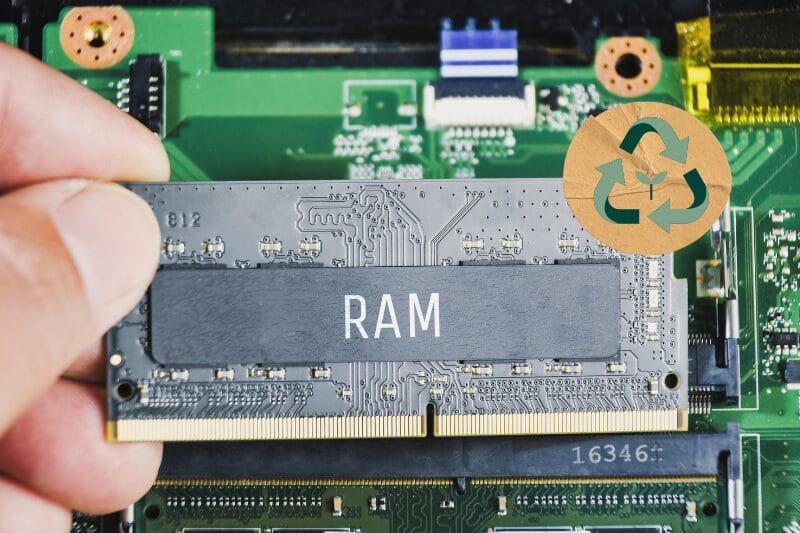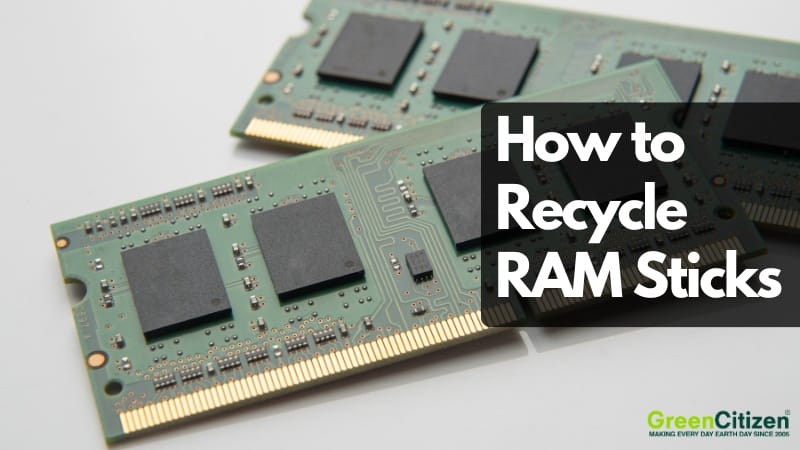Old RAM sticks tend to pile up after PC upgrades — maybe from a tech refresh at work or switching out parts in a home build. They’re small, outdated, and often ignored until someone wonders what to do with them.
But tossing RAM in the trash isn’t just careless — it’s illegal, as they are considered e-waste. Each memory module holds recoverable metals like copper and gold, along with components that can leach toxins into soil and groundwater.
So, how do you recycle RAM sticks the right way? Take them to an e-waste recycling center, use a mail-in service, or repurpose them if they still work.
Whether you’re dealing with DDR3, DDR4, or DDR5 modules for desktops or laptops, old RAM recycling is simple once you understand your options — and far better for the planet than sending them to landfill.
Key Takeaway: What to Do with Old RAMs?
The safest way to recycle RAM sticks is through certified e-waste programs that recover metals like gold, copper, and palladium while preventing hazardous waste. Whether DDR3, DDR4, or DDR5, old memory modules should never be trashed. Recycle, reuse, or resell them to conserve resources and protect the environment.
Can You Recycle RAM?
Yes — RAM sticks are recyclable because they’re built on printed circuit boards (PCBs) with metals like gold, copper, and palladium. Certified e-waste recyclers process these modules to safely extract the metals, recycle the plastic casings, and keep toxins out of the environment.
It’s important to understand that RAM is considered e-waste, not household trash. When RAM ends up in the trash, those valuable resources are lost and the circuit board can release hazardous chemicals over time. Modern recycling methods — from mechanical shredding to advanced chemical recovery — ensure that memory modules are dismantled responsibly and their materials re-enter the supply chain.
👉 Companies recycling RAM in bulk should ask for environmental impact or chain-of-custody reports. This helps with ESG goals and regulatory compliance.
How to Recycle RAM Sticks (Step-by-Step Guide for DDR3, DDR4, and DDR5 Memory Modules)
To recycle RAM sticks, identify whether they’re DDR3, DDR4, or DDR5, check their condition, remove them safely, store in an anti-static bag, and bring them to a certified e-waste recycler for proper RAM disposal.

Here’s how you should do it:
Step 1: Identify the RAM Type and Speed
Check whether your memory module is DDR3, DDR4, or DDR5, and note its bus speed (MHz) and brand. While all generations follow the same recycling process, these details matter for resale or donation.
DDR5 and some DDR4 sticks may still carry market value, while older DDR3 modules are usually recycled strictly as e-waste.
Step 2: Inspect the Module’s Condition
Look for broken pins, cracked chips, or scorch marks. If the RAM is intact and still functional, it could be recycled.
Damaged or non-working modules, however, must go directly to e-waste recycling to prevent hazardous waste from entering the environment.
Step 3: Remove RAM Safely and Store Properly
Carefully uninstall the RAM from your desktop or laptop. Always ground yourself to avoid static discharge and place the sticks in an anti-static bag or protective container.
This prevents additional damage and ensures the module is safe for reuse, resale, or certified RAM disposal.
Step 4: Recycle Through Certified E-Waste Programs
Bring your RAM sticks to a local e-waste collection program or mail them to a certified recycler.
Choose R2 or e-Stewards certified services to ensure valuable metals like gold, copper, and palladium are recovered responsibly and toxic materials are handled safely during memory module recycling.
Quick Answer: How to Recycle RAM Sticks Step by Step
Identify whether your RAM is DDR3, DDR4, or DDR5.
Check condition — whether intact or damaged, you should bring old and unused RAMs for recycling.
Remove safely from your PC and store in an anti-static bag.
Recycle through an R2 or e-Stewards certified e-waste program for proper RAM disposal.
Where To Recycle RAM Sticks Near You
When it comes to RAM disposal, you have several safe and convenient choices. The right option depends on whether you’re recycling a few memory modules at home or handling bulk e-waste from an office IT refresh.
A. Drop-Off at Local E-Waste Centers
Drop-off centers are the fastest way to recycle RAM sticks near you. Most accept DDR3, DDR4, and DDR5 modules along with other computer parts like CPUs and hard drives.
This option keeps your old RAM out of landfills and ensures the metals inside — including copper and trace gold — are recovered instead of wasted.
B. Certified Electronics Recyclers
For guaranteed compliance and accountability, use a certified RAM recycling program. R2 and e-Stewards certified recyclers follow strict standards, making sure metals such as gold, copper, and palladium are safely extracted.
Many also work with RAM scrap buyers so valuable resources re-enter the supply chain instead of being shipped overseas.
Certified recyclers offer the highest level of environmental and data security assurance.
C. Mail-In Recycling Programs
If you only have a few sticks and no nearby recycling drop-off, mail-in RAM disposal programs are convenient. Most providers offer prepaid labels so you can package your modules securely and ship them directly to a recycling facility.
It’s an easy way for individuals to clear out old DDR3 or DDR4 sticks without leaving home.
D. Bulk RAM Recycling for Businesses
For companies handling dozens or even hundreds of memory modules during IT upgrades, bulk RAM recycling is the best option.
Corporate IT asset disposition (ITAD) programs include scheduled pickup, chain-of-custody tracking, and certified recycling of all memory modules.
Businesses also receive environmental reporting to prove compliance with hazardous electronic waste regulations while reducing costs and saving internal resources.
How to Recycle RAM with GreenCitizen (For Bay Area Businesses and Individuals)
When it comes to recycling RAM, choosing a trusted local partner makes all the difference. GreenCitizen has been serving the San Francisco Bay Area since 2005, working with more than 70,000 businesses and 400,000 residents to keep e-waste out of landfills.
Every RAM module we handle is tracked through our GreenCitizen Total Accountability Management System (GTAMS), ensuring metals are recovered responsibly and nothing is illegally exported overseas.
Local Drop-Off at the Burlingame EcoCenter
Bay Area residents can bring old RAM sticks directly to our Burlingame EcoCenter. Our certified staff will make sure your memory modules are processed safely, whether you’re recycling a single stick or clearing out multiple laptops.
Business Recycling Pickup Across the Bay Area
For companies upgrading IT systems, GreenCitizen offers secure business pickups across San Francisco, San Jose, Oakland, Palo Alto, and beyond.
We manage bulk RAM recycling as part of full IT asset disposition (ITAD) services, including chain-of-custody tracking, environmental reporting, and compliance with R2 and e-Stewards standards.
Nationwide Mail-In Recycling Program
Not in the Bay Area? Our mail-in program lets individuals and businesses ship RAM and other small electronics directly to us for certified recycling. Simply package your modules safely, and we’ll handle the rest.
Does RAM Recycling Differ by Brand? (Corsair, Kingston, Samsung & More)
The recycling process itself is the same across all RAM brands — whether it’s Corsair, Kingston, G.Skill, or Samsung.
But differences in resale value, market demand, and material recovery potential make some brands more attractive to resellers or scrap buyers. Here’s what matters:
Gaming RAM (Corsair, Kingston HyperX/FURY, G.Skill, Team T-Force)
High-performance gaming sticks often retain resale value longer because enthusiasts buy older modules for budget builds. Models like Corsair Vengeance or G.Skill Trident Z may sell secondhand if they’re DDR4 or newer.
Once they lose resale demand, these sticks still contain copper and trace amounts of gold, making them suitable for scrap recovery.
Enterprise & Server RAM (Samsung, Hynix, Crucial OEM)
Brands like Samsung and Hynix dominate in laptops, servers, and data centers. These modules are usually replaced in bulk during IT upgrades, which makes them prime candidates for corporate recycling and IT asset disposition (ITAD) programs.
While resale potential is limited, enterprise RAM contributes significantly to scrap recovery because of its volume.
Consumer & Budget RAM
Mainstream and budget modules generally lose resale value quickly, especially DDR3. Their main worth lies in metals recovery — gold, copper, and palladium extracted from the circuit boards.
For individuals, recycling through certified e-waste programs is the most practical path.
FAQ
Yes. RAM sticks contain trace amounts of gold in their edge connectors and circuitry, along with copper and palladium. While the quantity per module is small, recyclers recover these metals through specialized processes, making RAM valuable for e-waste recycling.
No. RAM is classified as electronic waste and should never go in household trash. Landfilled modules can leach toxic substances from their printed circuit boards, and in many states, improper disposal violates e-waste regulations. Always recycle through certified programs.
Yes, but only if the new system supports the same DDR generation. For example, DDR3 modules will not fit DDR4 or DDR5 slots. If compatible, RAM can be reused, resold, or donated. Otherwise, it should be recycled to recover metals safely.
You can recycle DDR3, DDR4, and DDR5 modules at local e-waste drop-off centers, certified R2 or e-Stewards recyclers, or through mail-in recycling programs. Search “recycle RAM near me” to find nearby facilities that accept memory modules.
RAM scrap buyers and certified recyclers purchase modules to recover metals like gold, copper, and palladium. DDR4 and DDR5 sticks may also fetch resale value in secondhand markets, while older DDR3 modules are usually worth only their scrap recovery value.
Final Thoughts: How to Recycle Old RAM Sticks Safely
Old RAM modules may look small, but they pack valuable metals like gold and copper that shouldn’t end up in landfills. Whether it’s DDR3, DDR4, or DDR5, every memory stick counts as e-waste and requires safe handling.
The best options include local e-waste drop-off centers, certified recyclers like GreenCitizen, mail-in programs for individuals, or bulk ITAD services for businesses. If modules are still functional, you can also consider reuse, resale, or donation.
The bottom line: never throw RAM in the trash. Recycling protects the environment, conserves resources, and gives your old hardware a second life.
